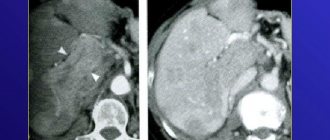Home / Cardiologist / Treatment of vascular insufficiency
Vascular insufficiency is a phenomenon that is associated with the pathology of the circulatory system due to deterioration in the tone and elasticity of blood vessels, as well as problems with the passage of blood through them and directly with the amount of blood itself. As a result of a decrease in blood flow speed, the transport of oxygen and nutrients across cell membranes is disrupted. Hypoxia develops and the functioning of cells and tissues is disrupted.
Pure vascular insufficiency is rare; most often, heart muscle insufficiency occurs simultaneously with symptoms of vascular insufficiency.
Types of vascular insufficiency
Based on localization, vascular insufficiency can be divided into: regional (affecting a specific part of the body) and systemic (affecting the vessels of the whole body).
According to the speed of formation and progression, acute and chronic vascular insufficiency are distinguished.
- Acute failure develops when there is a sharp drop in the level of pressure in the vessels, for example, with cardiogenic shock due to myocardial infarction. Characterized by the development of collapse due to a pronounced drop in blood pressure.
- Chronic failure develops over time when blood pressure drops below 100/60 mmHg. This concept includes a wide group of diseases: thrombophlebitis, vertebrobasilar insufficiency, coronary heart disease, mesenteric vascular insufficiency and other conditions accompanied by ischemia. Chronic vascular insufficiency can be primary (develops when the activity of the autonomic nervous system is disrupted) and secondary (due to various diseases).
Tissue respiration stimulants
For this purpose, the enzyme preparation Cytochrome C , which is produced from the heart muscle of cows. The active substance is a participant in the act of tissue respiration and can accelerate oxidative reactions. Known as one of the components of Katachrom drops.
The drug is prescribed as an intramuscular injection of 5 ml. Before starting the course, a test is performed, the frequency of daily injections is 1 or 2. The duration of treatment is up to 20 days.
A test is required before each treatment course. With its help, the individual sensitivity of the patient is determined. As a test, 0.1 ml of Cytochrome C is injected into the skin and observed for half an hour. If redness, itching or allergic rashes occur, individual intolerance is indicated and the appointment is cancelled.
Causes of vascular insufficiency
The acute variety occurs in various cardiac pathologies, massive blood loss, poisoning, severe infections, adrenal insufficiency, organic damage to the nervous system, extensive burns, traumatic brain and general injuries.
The root causes of the chronic form are autonomic and neurological factors, organic lesions of the brain stem and heart, in which there is hypotension with constant low blood pressure and, as a consequence, constant systemic hypoxia of organs and systems, the impossibility of adequate tissue perfusion with increasing consumption due to stress.
Anticoagulants
Heparin , as an active substance, has a multicomponent effect: absorbable, lipotropic, anticoagulant. It is prescribed in the form of intramuscular injections according to the following scheme: the first 4 days, 4 daily injections, the next 4 days, 3 injections, then 4 days, 2 injections and another 4 days, 1 injection.
The dosage is up to 5000 units. The drug is not used in large doses as complications are possible.
Iodine preparations are prescribed to increase the fibrinolytic activity of the blood. In addition, they reduce the content of b-lipids and cholesterol. Prescribed orally 5-10 drops in milk twice or thrice a day, or in the form of pills with a dosage of 0.0005 g. The course of treatment is at least one month, carried out intermittently for many years.
Symptoms of vascular insufficiency
Manifestations of vascular insufficiency depend on the type of insufficiency.
Acute vascular insufficiency
- Collapse – develops with a sharp decrease in blood pressure. It develops suddenly, when within a few seconds a person begins to feel severe weakness, noise in the head, dizziness, and the appearance of a “veil” before the eyes. The man loses consciousness. The patient's skin is pale, cold, breathing is rapid and shallow.
- Fainting – develops with a sudden disruption of cerebral circulation. The patient loses consciousness for several seconds or minutes, followed by darkening of the eyes, ringing in the ears, and severe weakness.
Chronic vascular insufficiency
Has signs of ischemia of organs and tissues, which has not clearly expressed signs:
- Cold extremities
- Blue discoloration of soft tissues in the periphery (fingertips, nose, earlobes)
- Trophic disorders (loss and fragility of hair, nails, loss of turgor and elasticity of the skin)
- Reduced pain and temperature sensitivity
- Weakness in the limbs, especially after exercise
- Muscle wasting
- Fast fatiguability
- Chronic cerebrovascular insufficiency is manifested by frequent headaches, dizziness, clouding of consciousness, decreased memory, attention, and ability to concentrate
- Chronic mesenteric ischemia is manifested by symptoms of dyspepsia (nausea, vomiting), abdominal and epigastric pain
Drugs that promote resorption
Chymotrypsin is a drug that helps break down blood clots, exudates, and fibrin. Prescribed as intramuscular injections of 5-10 mg in saline solution, lasting 20-30 days.
Fibrinolysin is a drug with high activity against fresh blood, so if the hemorrhage has occurred recently, treatment begins with it. It is prescribed as a sub injection in combination with fibrinolysin and heparin for 10-15 days. If necessary, chymotrypsin can be used after this. If the hemorrhage occurred a long time ago, it is not advisable to administer Fibrinolysin.
Another drug in this group, Lidaza, is contraindicated in recent hemorrhages. And in case of long-standing hemorrhage, it can provoke it again, therefore it is also contraindicated.
Diagnosis of vascular insufficiency
To the extent that the symptoms of vascular insufficiency are not always pronounced, to clarify the diagnosis of the pathology and then select the optimal treatment regimen, the patient will need to undergo several types of examinations. Among them:
- Orthostatic test. Control of pressure in a state of activity, passivity, when changing body position.
- Plethysmography. Necessary for determining vascular tone.
- ECG diagnostics. It is carried out to identify pathologies of the heart muscle in hemodynamics.
- Ultrasound diagnostics of the heart. Allows you to determine the need for treatment of existing heart diseases.
A comprehensive diagnosis will reveal the cause-and-effect relationship between symptoms and characteristics of the disease, which in turn will allow the doctor to choose the right treatment regimen and effective prevention methods in the future.
How to reduce the risk of side effects
An important role is played by the choice of the form of release of the drug, with the most unsuccessful form being nasal drops. In the absence of a dispenser, simply infusing the drug with a pipette does not provide any way to control the amount of drug introduced into the nasal cavity, since most of it immediately enters the nasopharynx and is swallowed. This not only reduces the effectiveness of the drug, but also significantly increases the risk of systemic side effects. Studies have shown that xylometazoline metered spray with a pump is significantly more effective at improving nasal breathing than regular spray and drops.
The concentration of the solution used is equally important. Studies have shown that 0.1% and 0.05% solutions of xylometazoline have approximately the same vasoconstrictor effect, so it is preferable to start treatment with a lower concentration of the drug (intended for children) and only if its effectiveness is insufficient, switch to the standard adult form.
Treatment of vascular insufficiency
The key treatment for vascular insufficiency over the past few years has been the administration of angiotensin converting enzyme inhibitors. This group of drugs dilates arteries, reduces peripheral vascular resistance, helps restore the function of their inner lining, and facilitates the work of the heart. If symptoms of vascular insufficiency develop against the background of the diagnosis of another pathology, the main treatment should be aimed at eliminating the root cause.
The best prevention of vascular insufficiency is the prevention of diseases that can cause it. It is recommended to monitor the condition of blood vessels, consume less cholesterol, and undergo regular examinations of the circulatory system and heart. In some cases, hypotensive patients are prescribed a prophylactic course of blood pressure-maintaining medications.
In our Medical City Alexandrov, the appointment is conducted by an experienced cardiologist, a high-class specialist who will conduct a comprehensive diagnosis of the disease and prescribe the necessary treatment.
By contacting us, you can be sure of a quality result!
To make an appointment with a specialist and find out all the details, please call: 8 (49244) 9-32-49
What foods should you eat to strengthen the walls of blood vessels?
The main role in the healthy functioning of blood vessels and the entire body is played by properly selected nutrition. In order to strengthen blood vessels, it is necessary to eat:
- Vegetables and herbs are irreplaceable products that should be present in every meal. All plant foods contain large amounts of vitamin C and potassium - these are 2 important components that affect the health of the veins.
- Legumes. They contain components that prevent the deposition of cholesterol on the walls of blood vessels. In addition, they improve the elasticity of blood vessels.
- Decoctions of herbs and berries. They have a positive effect on the entire venous system thanks to antioxidants. Replace coffee with rosehip infusion and you will feel an improvement in the functioning of your entire body.
- Milk and dairy products. Due to their composition, cheeses and milk are easily absorbed by the body and do not overload it.
- Fish and seafood. Their daily consumption is an excellent prevention of vascular disease.
- Bitter chocolate. It has a positive effect on blood vessels throughout the body and reduces the risk of cholesterol plaques. Only chocolate should not contain sugar.
Remember that to strengthen the walls of blood vessels, it is not enough to change just your diet. You need to choose a gymnastic set of exercises for yourself and perform them regularly, give up bad habits and reduce the activity of cosmetic procedures. For patients suffering from congenital vascular problems, more drastic measures are required using medications and wearing compression garments.
Stimulant drugs
Phibs is a biogenic stimulant produced from distilled mud from estuaries. Prescribed in the treatment of blepharitis, conjunctivitis, keratitis, myopia, vitreous opacities.
It is administered in the form of subcutaneous injections of 1 ml, the course of treatment is 30 injections.
ATP is a substance that regulates the energy metabolism of cellular reactions, mainly during the synthesis of RNA and DNA. Thanks to its action, the processes of alteration and exudation are stopped and redox reactions are stimulated. Subconjunctival administration of ATP results in its accumulation in the eye tissues without complications.
It is prescribed subconjunctivally in 0.2 ml or intramuscularly in 1-2 ml. Course of treatment: 15 subconjunctival injections or 25 intramuscular.
Peat is a derivative of distilled peat. Indications for its use, dosage and course of treatment are similar to the drug FiBS.
Aloe extract is a very effective drug in the treatment of a number of eye diseases: blepharitis, conjunctivitis, keratitis, uveitis, progressive myopia, vitreous opacities, etc.
It is prescribed as a subcutaneous injection in a dosage of 1 ml.
Not indicated for patients with severe cardiovascular diseases, hypertension, acute gastrointestinal disorders, severe kidney diseases. And also for older people.
The beginning of the beginning: classification of lipid-lowering drugs
First of all, let’s remember what lipid-lowering drugs are currently available in pharmacies.
Table 1: Lipid-lowering drugs
| Drugs that lower blood levels primarily of cholesterol (LDL) | ||
| Cholesterol synthesis inhibitors (3-hydroxy-3-methylglutargyl coenzyme A reductase inhibitors, or statins) | atorvastatin, lovastatin, pitavastatin, pravastatin, rosuvastatin, simvastatin, fluvastatin | |
| Inhibitors of cholesterol absorption from the intestine | ezetimibe | |
| Drugs that lower blood levels primarily of triglycerides | Fibric acid derivatives, or fibrates | gemfibrozil fenofibrate |
| Drugs that lower blood cholesterol (LDL) and triglycerides (VLDL) | Nicotinic acid | |
Lipid-lowering drugs normalize the lipid profile through various mechanisms. Among them [1, 2]:
- the most common mechanism of action: activation of lipoprotein uptake due to stimulation of LDL receptors located in the liver;
- blocking the synthesis of lipids and lipoproteins in the liver;
- inhibition of the absorption of cholesterol and bile acids from the intestine;
- activation of cholesterol catabolism, including its conversion into bile acids;
- stimulation of the activity of the enzyme that breaks down lipids - lipoprotein lipase of the vascular endothelium;
- blocking the synthesis of fatty acids in the liver and their release from adipose tissue (inhibition of lipolysis);
- an increase in the level of antiatherogenic HDL in the blood.
Let's take a closer look at how representatives of various subgroups of lipid-lowering drugs work and what features they have.
Questions from patients about the differences between a phlebologist and a vascular surgeon
What is the difference between a phlebologist and a vascular surgeon?
A vascular surgeon deals with the entire complex of vascular pathology, with a more emphasis on the pathology of the arterial bed. A phlebologist specializes exclusively in venous pathology.
Which doctor should I consult with a venous trophic ulcer on the leg, a phlebologist or a vascular surgeon?
In this situation, preference should be given to a phlebologist. It is the phlebologist who will be able to provide the most effective and comprehensive assistance in this profile.
Does a vascular surgeon treat varicose veins in a public hospital?
A vascular surgeon in a public hospital treats varicose veins due to the instrumental, technical and logistical capabilities that he has. The most effective and high-tech treatment will be carried out by a phlebologist in a modern phlebological center.
Which doctor is better versed in diseases of the veins of the lower extremities, a phlebologist or a vascular surgeon?
Due to the specific nature of practical activity and professional orientation, a phlebologist is better versed in venous diseases. If the main activity of a vascular surgeon is vein pathology, then in essence he is a phlebologist.
Antisclerotic drugs
Miscleron has the ability to reduce the level of lipids and uric acid in the blood, increase its viscosity and fibrinolytic activity, and reduce platelet aggregation. Due to this, it is widely used for diabetic retinopathy, as well as other conditions associated with hyperlipidemia.
It is recommended to take the drug three times a day, 2 capsules during or after meals. Courses of treatment usually last 20-30 days, followed by an equal break; it is advisable to take 4-6 such courses per year.
Taking Miscleron may be accompanied by: gastrointestinal disorders, skin itching, muscle weakness and pain, weight gain due to water retention. Long-term use of this drug can cause intrahepatic cholestasis and cholelithiasis. Therefore, many European countries abandoned its production.
The drug should not be taken by people with liver and kidney diseases, as well as during pregnancy and lactation. Prescribed with caution to diabetics.
Methionine is a drug containing essential amino acids. Its lipotropic effect is aimed at removing excess fat from the liver. In addition, it has the property of activating hormones, vitamins and enzymes, and neutralizing toxic substances. Methionine is used for toxic liver damage, prescribed for diabetes mellitus, atherosclerosis (to reduce blood cholesterol levels and increase phospholipid levels).
It is taken 2 tablets (0.5 g) before meals 3-4 times daily, lasting from 10 days to a month. Sometimes, the course of treatment is longer: 10 days of taking pills, 10 days of rest.
An unpleasant consequence of treatment with Methionine is vomiting, which requires its discontinuation.









